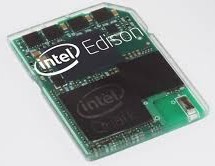
Intel is extremely involved into the new innovations of wearable technology with their very interesting and upcoming device, the Intel Edison.
Intel Edison is an SD-card sized tiny computer that features:
- Intel Atom SoC based on leading-edge 22nm Silvermont micro-architecture including a dual-core CPU and single core microcontroller (MCU)
- Integrated Wi-Fi, Bluetooth LE, memory, and storage
- Support for more than 30 industry-standard I/O interfaces via a 70-pin connector
- Support for Yocto Linux, Arduino, Python, Node.js, and Wolfram
- Open source community software tools enabling ease of adoption and inspiring third-party app developers to build apps for consumers.
After Intel announced an upgrade prior to their summer launch, the Edison embedded platform has changed from their initial SD card size tiny computer to the slightly larger platform. “The Atom-based Edison won’t replace the planned Quark version,” Intel claims, “but instead augment it as part of a new Edison-branded range of products.”
Intel is also involved in wearable technology with their MAKE IT WEARABLE challenge. Its a global year-long initiative sponsored by Intel to support the evolution of wearables. Students, designers, engineers, and makers can get involved in two ways: the VISIONARY track and the DEVELOPMENT track.
VISIONARY Track:
Submit a 1-minute video along with a description of your idea. Concepts will be reviewed and judged in 5 waves on the basis of inventiveness and potential to positively impact the world. You can submit up to 10 concepts. Selected participants receive:
- personal story featured online
- invitation to Final Gala event
- Travel package for 2 to San Francisco
- 4 night hotel accommodations in San Francisco
- $5,000 (5 winners)
DEVELOPMENT Track:
Submit a proposal and pitch video of an innovative and creative product concept. Submissions will be judged on a balance of creativity, feasibility, and market potential. As participants advance to semifinal and final rounds, they will receive mentorship. Selected participants receive:
- Increasing guidance & mentorship throughout program
- Business, design, and technical development support
- Intensive incubation and education
- $50,000 to finalists (10)
- $500,000 grand prize (1)
For more details on the MAKE IT WEARABLE challenge, visit makeit.intel.com.
This blog post was written by an engineering intern at Sparx. If you too are interested in learning in a fast-paced engineering environment, send your resume and description of your engineering schooling to careers@sparxeng.com